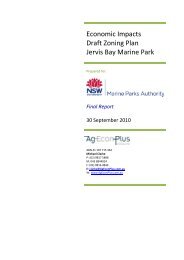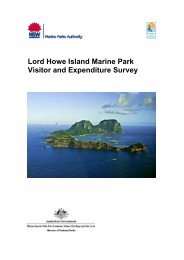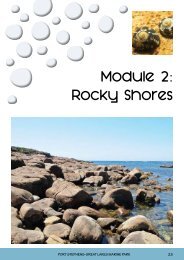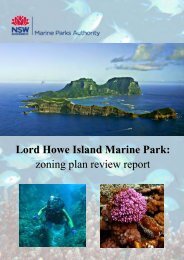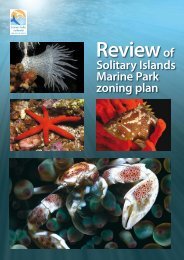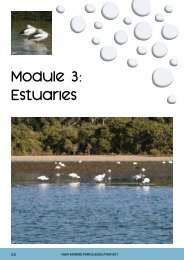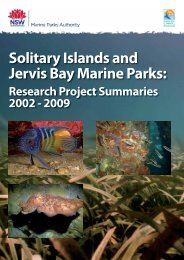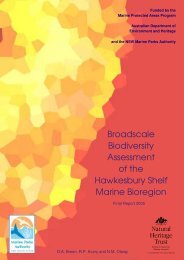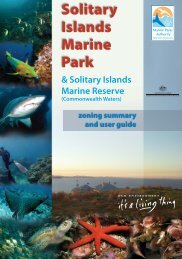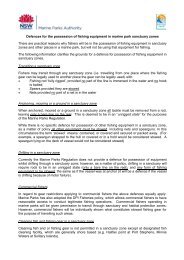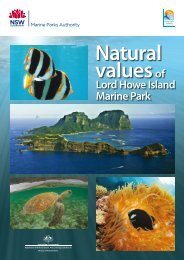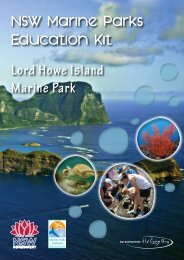Natural values of the Solitary Islands Marine Park - Marine Parks ...
Natural values of the Solitary Islands Marine Park - Marine Parks ...
Natural values of the Solitary Islands Marine Park - Marine Parks ...
- No tags were found...
Create successful ePaper yourself
Turn your PDF publications into a flip-book with our unique Google optimized e-Paper software.
18 <strong>Natural</strong> <strong>values</strong> <strong>of</strong> <strong>the</strong> <strong>Solitary</strong> <strong>Islands</strong> <strong>Marine</strong> <strong>Park</strong>Shallow benthic assemblages around North andSouth <strong>Solitary</strong> islands differ greatly. South <strong>Solitary</strong>Island has a higher cover <strong>of</strong> foliose coral (coralwith a skeleton like a broad, flattened plate) andcompound ascidians, and a lower cover <strong>of</strong> largeanemones, zoanthids, algae and s<strong>of</strong>t coral (Smithand Edgar 1999). The mobile benthic invertebratesthat occur round <strong>the</strong>se islands also differ (Rule andSmith 2005).Figure 20.Massive sponge.Figure 21.Spindle cowrie shell onsponge.4.1.4 Intermediate <strong>of</strong>fshore reefsSwath-mapping has revealed considerable areas <strong>of</strong>reef at intermediate depths in <strong>the</strong> <strong>of</strong>fshore region <strong>of</strong><strong>the</strong> marine park (Figure 13). Much <strong>of</strong> this occurs on <strong>the</strong> eastern side <strong>of</strong> South <strong>Solitary</strong>Island and western side <strong>of</strong> North <strong>Solitary</strong> Island. The coarse-scale bathymetry alsoidentifies a large area <strong>of</strong> reef several kilometres east <strong>of</strong> North West <strong>Solitary</strong> Island,associated with Wrights Reef and Woolgoolga Wash.In <strong>the</strong> NSW waters <strong>of</strong> <strong>the</strong> marine park, <strong>the</strong> extent <strong>of</strong> <strong>the</strong> intermediate reefs is greatestadjacent to South <strong>Solitary</strong> Island, with a large number <strong>of</strong> individual patches <strong>of</strong> reefextending to at least 3 kilometres east <strong>of</strong> <strong>the</strong> island.A large area covering about 10 kilometres by 5 kilometres at <strong>the</strong> nor<strong>the</strong>rn end<strong>of</strong> <strong>the</strong> marine park also contains extensive intermediate reefs, including at leastfour individual continuous reefs that are at least 1 kilometre long, and numerouspatchy reefs that are generally less than 200 metres long. Reefs are separated byunconsolidated sediments that, from preliminary surveys, appear to be coarse sands.Most <strong>of</strong> <strong>the</strong>se reefs are in <strong>the</strong> <strong>Solitary</strong> <strong>Islands</strong> <strong>Marine</strong> Reserve (Commonwealth Waters)(Figure 13). A towed video survey <strong>of</strong> <strong>the</strong> benthic environment in <strong>the</strong> marine reserveidentified five types <strong>of</strong> reef habitat: three types <strong>of</strong> patchy reef, continuous reef, andpinnacle reef (The Ecology Lab 2006).Many reefs more than 25 metres deep contain mixed ‘sponge gardens’. These aremade up <strong>of</strong> a community <strong>of</strong> sessile filter feeders that, as well as sponges, containinvertebrates such as stalked ascidians, black corals, hydrozoans, gorgonians,anemones, s<strong>of</strong>t corals and bryzoans, in various stages <strong>of</strong> growth. Many <strong>of</strong> <strong>the</strong>sespecies also occur on shallow reefs where walls, overhangs and caves providesuitable habitat, or as part <strong>of</strong> <strong>the</strong> understorey beneath macroalgae. Very little isknown about <strong>the</strong> diversity <strong>of</strong> sponges, although at least 100 species <strong>of</strong> sponge arelikely to occur along <strong>the</strong> central coast <strong>of</strong> NSW, in shapes ranging from encrusting tomassive erect structures (Roberts and Davis 1996) (Figure 20).4.1.5 Deep <strong>of</strong>fshore reefsOnly a small amount <strong>of</strong> deep rocky reef over 60metres deep has been mapped in <strong>the</strong> marine park,primarily east <strong>of</strong> North and South <strong>Solitary</strong> islands(Figure 13). Little is known about <strong>the</strong>se deep reefs,but benthic assemblages are likely to be dominatedby sponges and ascidians, and some species mayonly be found at <strong>the</strong>se depths. Based on resultsto date, and <strong>the</strong> potential for a paleo-coastline ata depth <strong>of</strong> about 60–70 metres, fur<strong>the</strong>r swath-



